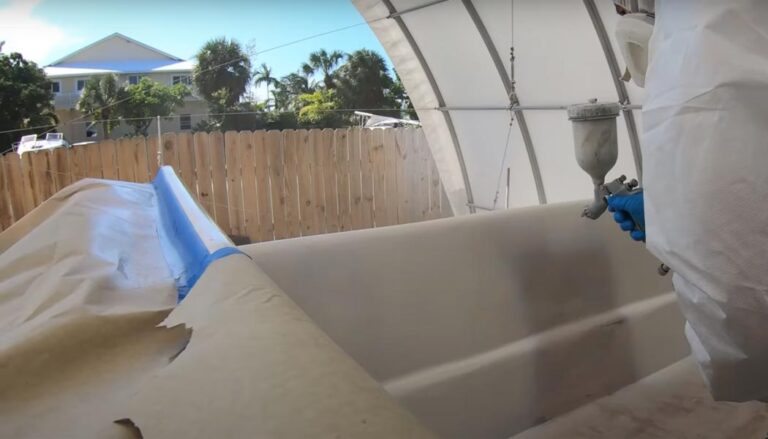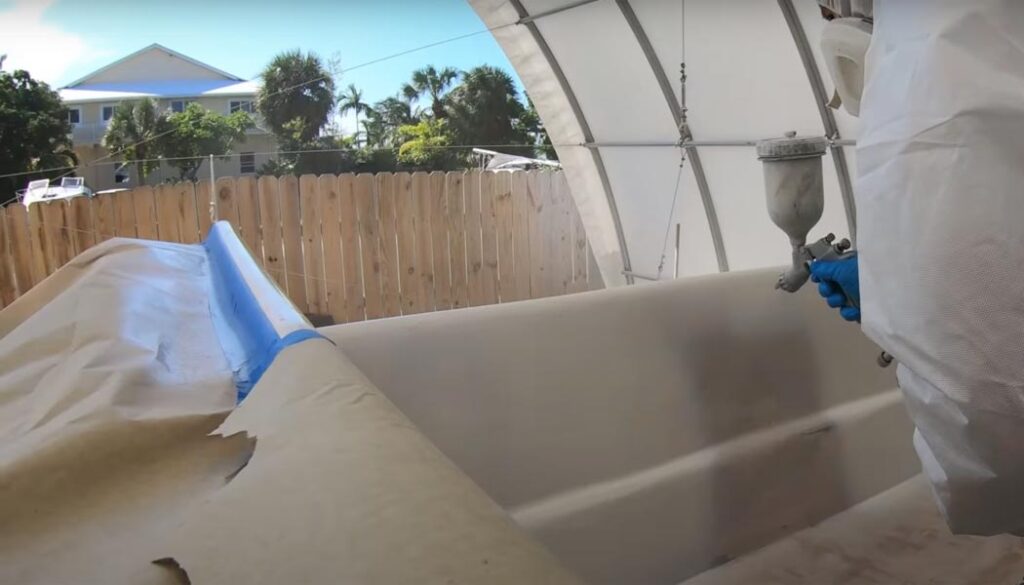
Can You Paint Starboard? [Unlock Your Creativity]
From sailboats to yachts, there is an age-old question that has crossed the minds of many maritime enthusiasts: “can you paint starboard?” Of course, you can.

In this article, we will uncover the secrets behind painting starboard, and discover the endless creative possibilities that lie ahead. So, let’s set sail on this artistic journey together and discover the answers you seek.
What Is Starboard?
Starboard refers to the nautical term used to describe the right-hand side of a ship or boat when facing forward. It is the opposite of the port side, which is the left-hand side. The term “starboard” originated from the Old English word “steorbord,” which means “steering side.”
The use of starboard and port dates back to ancient times when ships were steered using oars. The steering oar was positioned on the right-hand side of the vessel. This positioning made it easier for right-handed sailors to control the ship’s direction. Over time, as ships evolved and the use of rudders became widespread. The term starboard continued to be used to indicate the right side.
Today, starboard remains an essential term in maritime navigation and is used to give clear and consistent directions aboard a ship. It is particularly crucial during maneuvers, docking, and communication between crew members. Understanding and using starboard and port correctly helps ensure safe and efficient navigation on the water.
What Type of Plastic Is Starboard?
Starboard is an exceptional form of plastic specifically crafted from high-density polyethylene (HDPE). This particular variant of plastic is sourced from petroleum.
This versatile and durable plastic is commonly used in various applications, including marine and outdoor settings. It is renowned for its excellent resistance to chemicals, moisture, and UV radiation. It’s also greatly known for its strength, stiffness, and exceptional water and weather resistance.
The key advantage of Starboard and HDPE plastics in general is their ability to resist corrosion, rot, and degradation over time. This makes them ideal for marine and outdoor applications where exposure to moisture and environmental elements is a concern.
Can You Paint Starboard?
Yes, you can paint starboard with the appropriate materials and proper preparation.
Painting starboard can offer several benefits, including a fresh and appealing appearance, protection against UV rays, corrosion prevention, and enhanced durability. A well-maintained and visually pleasing boat can leave a positive impression and potentially increase its value. Moreover, painting can help in identifying the starboard side more easily especially in low visibility or congested waterways.
When considering painting starboard, it is essential to select a marine-grade paint specifically designed to withstand the harsh conditions of the marine environment. These paints are formulated to resist fading, chipping, and peeling caused by exposure to sunlight, saltwater, and other environmental factors.
Choosing a suitable color scheme and design is important. Opt for colors that complement the overall look of your boat and adhere to any regulations or guidelines set by relevant authorities. Certain jurisdictions may require specific colors for different types of vessels to ensure visibility and safety.
One significant challenge when painting starboard is ensuring a dry surface before applying the paint. Moisture can have a negative impact on the paint’s adhesion and durability. This can result in premature peeling or fading of the painted surface. Therefore, it is crucial to plan the painting process when the vessel can be adequately dried and protected from water exposure.
Note: Different types of starboard, such as King Starboard or other high-density polyethylene (HDPE) materials, may have specific paint requirements and preparation techniques. Consulting the manufacturer’s guidelines for painting recommendations specific to the type of starboard you are working with is advisable.
How to Paint Starboard?
To paint starboard, you will need a few essential materials and follow a systematic process. The following is a detailed step-by-step guide on how to paint starboard:
Materials needed:
- Starboard surface to be painted
- Sandpaper (150-grit and 220-grit)
- Tack cloth
- Primer suitable for starboard (check with the manufacturer’s recommendations)
- Marine-grade paint suitable for starboard (check with the manufacturer’s recommendations)
- Paint roller or brush
- Paint tray
- Painter’s tape
- Drop cloth or plastic sheeting
- Safety goggles
- Dust mask
- Clean cloth or sponge
- Water
- Mild detergent (optional)
Step 1: Preparation
- Begin by ensuring that the starboard surface is clean and free of any dirt, dust, or contaminants. Wipe it down with a clean cloth or sponge dampened with water or a mild detergent solution if needed.
- Use painter’s tape to cover any areas adjacent to the starboard surface that you do not want to paint, such as metal or wooden trims.
- Lay down a drop cloth or plastic sheeting to protect the surrounding area from paint splatters or spills.
Step 2: Sanding
- Sand the starboard surface lightly using 150-grit sandpaper. Sand in a circular motion, applying even pressure. Make sure to cover the entire surface evenly.
- Once you have sanded the entire surface, switch to 220-grit sandpaper and repeat the process. This finer grit will further smooth out the surface and ensure better paint adhesion.
- After sanding, wipe away any sanding dust using a tack cloth. Make sure the surface is clean and smooth before proceeding to the next step.
Step 3: Priming
- Apply a suitable primer for starboard according to the manufacturer’s instructions. Use a paint roller or brush to apply an even coat of primer to the starboard surface.
- Start priming from one edge and work your way across the surface, ensuring complete coverage. Use long, smooth strokes for a consistent finish.
- Allow the primer to dry completely as per the manufacturer’s recommended drying time. This usually takes a few hours but can vary depending on the product and environmental conditions.
Step 4: Painting
- Once the primer is dry, it’s time to apply the paint. Stir the marine-grade paint thoroughly to ensure it is well mixed.
- Pour the paint into a paint tray and load your paint roller or brush with an appropriate amount of paint.
- Begin painting from one edge of the starboard surface. Work your way across the surface in smooth, overlapping strokes. Apply an even coat of paint to achieve uniform coverage.
- If needed, apply a second coat of paint after allowing the first coat to dry completely. Follow the manufacturer’s instructions regarding drying times between coats.
- Pay attention to any specific instructions regarding temperature or humidity conditions for optimal paint application and drying.
Step 5: Finishing touches
- After applying the final coat of paint, carefully remove the painter’s tape while the paint is still slightly wet to avoid peeling.
- Allow the paint to dry completely. This can take anywhere from a few hours to a few days, depending on the paint and environmental conditions.
- Once the paint is dry, inspect the starboard surface for any imperfections or unevenness. If necessary, lightly sand any rough areas with fine-grit sandpaper and touch up with additional paint.
- Clean up your work area and properly dispose of any leftover paint or materials according to local regulations.
Can Starboard Be Sanded?
Yes, StarBoard can be sanded. When sanding StarBoard, use a fine-grit sandpaper, such as 220-grit or higher. Start with a coarser grit if necessary and gradually move to a finer grit to achieve the desired smoothness. Always sand in a circular or back-and-forth motion, following the grain of the material.
What Sealant Will Stick to Starboard?
One of the most suitable sealant for Starboard is 3M 5200 Fast Cure Marine Adhesive Sealant. It is a high-performance polyurethane sealant that provides excellent adhesion to a variety of materials, including HDPE.
It forms a strong, waterproof bond that is resistant to weathering, saltwater, and UV radiation. The fast-curing formulation allows for quicker results, making it a reliable choice for sealing Starboard.
Other reliable options are Sudbury Elastomeric Marine Sealant and Sikaflex 291.
What Epoxy Will Stick to Starboard?
Marine-Tex Epoxy is a suitable adhesive for bonding to Starboard. It is specifically formulated for use in marine environments and is known for its excellent adhesion to various materials, including Starboard.
It is strongly resistance to water that make it an ideal choice for repairing, reinforcing, or bonding starboard surfaces in marine applications.
Is Starboard Waterproof?
Yes, Starboard is an inherently waterproof option designed specifically for water-related applications. This feature makes it suitable for use in wet environments such as boats, docks, and outdoor furniture.
There are different brands and variations of waterproof starboard available, such as King StarBoard® and TACO Marine Starboard.
Is Starboard Flammable?
No, starboard itself is not flammable. It is commonly constructed of sturdy materials such as steel, aluminum, or fiberglass, which are not easily flammable. However, the objects or materials stored on or near the starboard side may be flammable. It depends on their individual composition and properties.
Final Words
By following the recommended steps and using the right materials, you can transform the appearance of starboard while maintaining its durability and functionality. Always remember to consult with professionals or specialists in marine coatings for specific advice tailored to your unique requirements.
